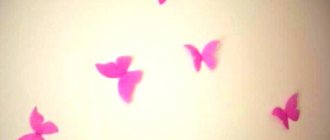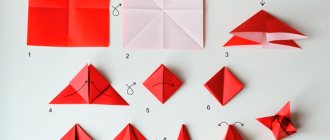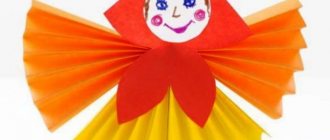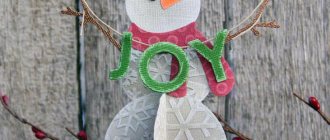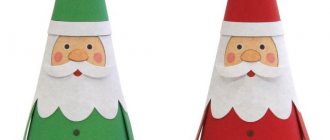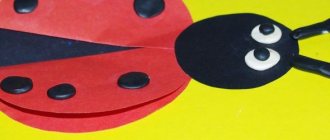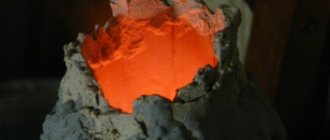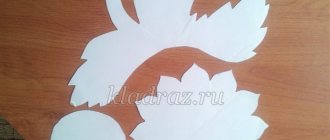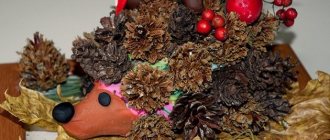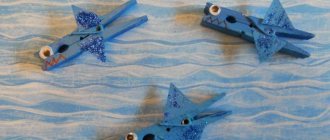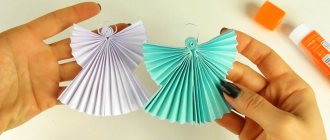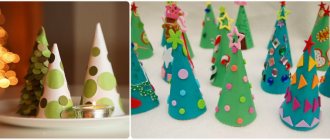Paper butterflies are a fairly popular decorative element. They look harmonious in children's rooms, bedrooms, living rooms and even in the kitchen. You can make such a decoration with your own hands, thereby creating a unique and inimitable decor.
- How to make a beautiful butterfly stencil for paper cutting
- Printing the template
- Hand drawn template
- How to make a voluminous butterfly from A4 sheet
- Wall decoration with butterflies
- Butterfly applique for children
- Wafer paper butterflies
- Paper bow tie
Preparatory work
The tradition of using paper butterflies as wall decoration arose relatively recently. Multi-colored moths can quickly transform the interior of a room, filling the atmosphere with romanticism and pleasant dreams of relaxation. The preparatory stage will help you achieve the desired result:
- It is better for paper butterflies to have a wall that is as free from foreign objects as possible. A good overview enhances the aesthetic pleasure of a handmade creation.
- Determine the area and shape of the image on the wall. It can occupy a compact area or be dispersed as much as possible over the surface.
- The easiest way to make butterflies is from colored paper, but there are still a lot of interesting ideas for decorating a wall with original butterflies. The manufacturing material and its compatibility with the interior of the room are thought out in advance.
- A wall with butterflies of different sizes looks impressive. Pre-prepared stencils for cutting will help you quickly complete the task.
Comment! When choosing a template, it is worth remembering the difficulty of cutting out intricate shapes.
The easiest way to make butterflies with your own hands
How to make a butterfly with your own hands, without spending a lot of materials and money? The answer is very simple. To make simple butterflies you only need colored paper.
It is advisable to use double-sided paper, since the white side of regular paper can slightly spoil the appearance of both the butterflies and the room as a whole. Butterfly stencils for making butterflies can be easily found on the Internet.
For butterflies, you can choose only one color, for example, black (if it matches the interior of the room), or choose several colors at once.
There are no restrictions here, as well as with their location. You can define them in a chaotic order, arrange them in a sequence by size or colors. It all depends on your imagination and desire to make the room more attractive.
Characteristics of individual materials for butterflies
You can make elegant moths for the wall with your own hands from various materials. Only paper models have several solutions:
- classic colored paper or double-sided colored sheet;
- cardboard;
- corrugated paper;
- newspapers and glossy magazines.
In addition to paper decor, other versions of original butterflies are used in the interior of the room:
- from vinyl records;
- a contour painted on the wall with phosphor paints, applied using a stencil;
- from nylon tights, which are covered with a wire frame;
- from cans or plastic bottles.
Advice! If you have no experience, it is recommended to make several copies from different materials, then attach them to the wall and choose the appropriate option.
Paper
The easiest and cheapest way to make moths with your own hands is from ordinary colored paper. There are several design techniques. If you plan to stick the entire butterfly on the wall, then paper painted on one side will do. When creating a three-dimensional composition, when only the body of the moth is fixed, it is preferable to use double-sided colored paper for work, so the appearance of the decorative elements will only benefit.
In addition to classic colored paper, pieces made of corrugated material look original on the wall. The butterfly turns out more airy and light, it is easier to give volume to the figure.
Moths on the wall look extraordinary when they are made using glossy magazines, postcards, newspapers or wallpaper. In addition to simply cutting butterflies out of paper, they can be additionally colored, combined with other shades of a similar material, or made multi-layered. There are practically no boundaries for the flight of creative imagination.
Cardboard
To cut out butterflies on the wall, select cardboard of low density. Otherwise, the process will cause a lot of trouble.
Comment! Cardboard is considered the most suitable material for decorating three-dimensional wall decor with moths. It holds the shape of the figure well.
Naturally, in this case it will not be possible to make a corrugated copy of the butterfly. Rigid material cannot be folded into small folds.
Cardboard is optimal for cutting out openwork moths. For decoration you will need a sharp stationery knife and a lot of patience. A high-quality result of wall decor is possible only with perseverance and the ability to carefully work with small details.
It is also better to prepare a butterfly stencil for subsequent cutting out numerous copies from cardboard. Original templates for cutting butterflies from paper are presented below:
Textile
To give the paper wall decor a complete look, it is sometimes supplemented with similar elements on the lampshade of the lighting fixture. But paper moths are not suitable here, so they turn to fabric analogues. Butterflies made from fabric are not complicated:
- Using a cardboard stencil, the outline of the figure is applied to the fabric;
- the part is cut out;
- the workpiece is given rigidity;
- if necessary, the moth is additionally decorated (wire antennae on the body or beads on the wings);
- The butterfly is attached to a suitable surface.
Advice! Experienced needlewomen can try imitating veins on the wings using a thread and a needle.
A little exotic
Extravagant people will love the idea of creating wall decor based on vinyl records. Key process steps:
- Initially, the outline of a butterfly is drawn onto the vinyl with chalk.
- In the initial state, the material is hard enough to cut a figure out of it; the plate needs to be softened. An oven with a foil-lined baking sheet or a microwave will help you accomplish your plans.
- When the vinyl becomes plastic, it is taken out and the shape is quickly cut out. If the butterfly has not acquired the desired shape before cooling, the heating process is repeated.
- At the final stage, the moth is given the required volume.
It is more difficult to attach a vinyl butterfly to the wall than a paper one. It cannot be removed later without damaging the surface.
The material for making a moth can be a sheet of tin or a beer can, which is pre-washed and straightened. The contours of the selected stencil are transferred to the material with a marker or an awl, and the workpiece is cut out. Decorate the figurine with nail polish or colored markers.
Attention! The edges of the butterflies turn out to be very sharp, so you need to work extremely carefully so as not to cut yourself.
Tin decor can be hung on a thread. It would be appropriate in a loft interior; for a classic design, paper butterflies would be the optimal solution.
How to make a beautiful butterfly stencil for paper cutting
Required tools:
- Thick cardboard or vinyl film
- Scissors
- Pencil
- Plain printer paper
Additional Information. You can also use old plastic coasters for the template.
The template should be dense, especially if a large number of identical elements are planned. You can use cardboard, which is sold at any office supply store. It is also convenient to work with templates made of vinyl film. It can be purchased at construction or hardware stores.
There are two options for creating a stencil:
- Draw by hand
Printing the template
You can quickly find many templates on the Internet. If none of them are suitable, then using graphic programs you can create your own unique drawing and make a stencil from it. This requires certain knowledge.
The printed drawing must be cut out, attached to the template material, traced with a simple pencil and cut out. The template is ready.
Hand drawn template
You need to take a sheet of paper the size of which corresponds to the future butterfly. Fold it in the middle and, starting from the fold, draw half of the insect. When the drawing is ready, carefully cut it out. This will make it symmetrical.
Additional Information! If you can’t draw it yourself and there is no printer to print the finished template, then you can simply attach a white sheet of paper to the computer monitor and copy the drawing that way. The hand should slide smoothly, without pressure, so as not to damage the surface.
Making outline butterflies
Let's start with the simplest option on how to make contour butterflies. Main stages of the creative process:
- It is better to cut butterfly stencils for the wall from medium-density cardboard. A suitable material would be cereal or tea packaging.
- The original moth can be selected and printed from the templates below.
- The silhouette you like is applied to cardboard and cut out. A wall with butterflies of different shapes on it looks more colorful.
Some useful tips for decorating paper butterflies:
- For cutting, use the entire figure; if you want to achieve perfect symmetry, the workpiece is folded in half.
- Specimens with minor asymmetrical deviations look more natural on the wall.
- If there is a need to obtain moths of different sizes, the template is converted through a graphic editor.
Butterflies on a paper wall
There are many ways to “settle” such wonderful insects as butterflies on your wall. One of them is a three-dimensional transparent painting, inside of which there is a dried butterfly of a rare species. It looks amazing, but not for those who are for the preservation of wildlife.
This exhibition is unlikely to please such people. Another, no less beautiful option would be butterflies made from feathers and wire. They often have variegated colors and look great on plain walls.
If you have walls with a pattern, then this option is unlikely to suit you, since such butterflies will get lost against this background. Or you can buy butterflies made from self-adhesive film and stick them wherever you want.
Design of openwork specimens
Openwork paper butterflies are best made using cardboard. To work, you will need a sharp knife, a blade and a printed template with lines for cutting. Obtaining high-quality decor on the wall is possible with painstaking work. The algorithm of actions differs only slightly from cutting out contour butterflies. First, select and print a template. The required number of elements is cut out from it.
Advice! It is first recommended to cut out the small details inside, and then move on to cutting out the outline of the butterfly.
Using a blade or a sharp knife can damage the surface of the table, so it is recommended to protect the table top with a sheet of plastic, plywood or chipboard. Openwork paper butterflies on the wall usually add volume. A little trick can make the process easier. The product is slightly moistened and rounded, the resulting bend is fixed. After the moisture evaporates, the workpiece will retain the desired shape.
Options for volumetric paper decor
Three-dimensional figures of paper moths look impressive on the wall. There are several options for creating butterflies of complex configurations:
- multilayer instances are created;
- use corrugated paper;
- the figures are formed by folding the sheet into several layers;
- The art of origami is deservedly popular.
Multilayer
Placing multilayer moths on the wall is quite simple:
- several blanks of the same shape are cut out of paper;
- color and size of parts may vary;
- the elements are placed one on top of the other, the bodies are glued together, and the wings are bent in different directions.
Multi-layer butterflies look impressive not only from contour blanks, but also from openwork details. To do this, you will need paper in contrasting colors or similar shades. For the upper part, an openwork blank is taken, the lower one remains contoured. The following photo will help you evaluate the result:
There is an interesting technique where you can make a multi-layer butterfly on the wall from one sheet of paper by folding it in a special way. The photo below demonstrates the simple manufacturing process:
Corrugated paper
It is quite easy to work with butterflies on a corrugated paper wall. The algorithm of actions includes the following steps:
- The required paper colors are selected.
- Rectangles are cut out with an approximate size of 7x10 cm.
- The blanks are stitched in the center with large stitches, after which they are assembled with an accordion and secured with thread in several turns.
- The resulting paper bow is folded in half, and the future wings of the butterfly are straightened.
- Then the desired configuration is cut out along the edges.
- Narrow strips form flagella for antennae, which are glued to the body.
The interesting process is clearly demonstrated by the photo:
Ideas for beginners and professionals
It’s very easy to prepare butterflies from double-sided colored paper for wall decoration:
- First, a diamond or square is cut out.
- The figure folds like a small accordion.
- The two pieces are joined together and secured in the middle with thread.
- The antennae are formed from wire.
The photo will help you follow the main stages of making butterflies for the wall:
The origami process, which is so interesting for children, is somewhat complex. One option for making a paper butterfly is presented below:
Wafer paper butterflies
They are quite easy to make, but it is worth considering that they are not very durable.
This waffle decor will perfectly complement a cake or decorate a festive table.
Materials:
- Corrugated paper
- Wooden or bamboo skewers
- Wire
- Scissors
- Paints
- Brushes
- Markers
- Hot glue gun
When the materials are prepared, you can start working and follow several steps step by step:
- Fold a sheet of paper in half and cut out butterflies. This can be done by eye or using a template. The butterfly should be approximately 8 cm in height and 5 cm in diameter.
- Move your fingers back and forth to crumple the paper.
- The center of the insect is secured with wire.
- Now the wings can be spread and smoothed. Corrugated material is easy to transform.
- Using acrylic paint and markers you can decorate butterflies.
- Glue them to the skewers with hot glue.
- Now you can insert it into a cake or any other baked goods.
Mounting options
You can securely fix paper butterflies on the wall in various ways:
- If the issue of preserving the wall surface is not relevant, PVA glue or wallpaper solution will help to secure the paper figures.
Comment! Regardless of the chosen template, whether it is a contour or an openwork butterfly, three-dimensional paper figures look more impressive on the wall. A light breeze can set the wings in motion, making them flutter like real ones. - Small pieces of polystyrene foam will also come in handy in the process, which are initially glued to the body of the butterfly and then to the wall.
- Similarly, double-sided tape is used instead of polystyrene foam.
- When the task is to maintain the integrity of the wallpaper after removing paper moths from the wall, they are secured with safety pins.
There are many options for creating decorative images on the wall using paper butterflies. A huge heart or a whirlwind receding into the distance, individually distributed specimens or a flock of flowers comfortably located on flowers - there are no limits to creative imagination.
Recommended Posts
Protecting plants from heat
Apartment aviary for dogs
White spirit: technical characteristics
Wallpaper or decorative plaster for walls
Drawing of laying paving slabs + photo
DIY wall mounted shelf + photo
